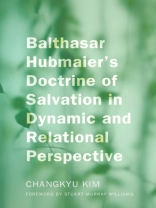This book aims to explore the meaning of salvation in Balthasar Hubmaier’s theology. Previous research has tended to explain and evaluate his theology by locating his identity among contemporary Anabaptists. Moreover, Hubmaier’s theology has been variously labeled as Catholic Anabaptist, Magisterial Anabaptist, or as a bridge between the Radical and Magisterial branches of the Reformation. These approaches to Hubmaier’s theology essentially depend on a static and transactional perspective where the result comes from the cause. Such an approach cannot fully explain the distinctive features of Hubmaier’s theology, because his theology had multiple rather than single influences. To understand Hubmaier’s theology, we need to focus on his motive and purpose in writing rather than external influences. This volume attempts to explore a new understanding of Hubmaier’s theology reflecting a necessary change in our paradigmatic methodologies. This fresh perspective helps us see that Hubmaier’s theology was not static and transactional but dynamic and relational. As Hubmaier’s main purpose was to give readers a proper understanding of soteriology, his writings were written from this perspective, concentrating on salvation. This volume aims to enable the reader to access this unique understanding of soteriology by examining his primary texts in three categories: free will, baptism, and the Lord’s Supper. To understand Hubmaier’s theology through a new methodology leads us to rethink the meaning of salvation.
Over de auteur
Stuart Murray has a Ph.D. in Anabaptist hermeneutics from The Open University, under the auspices of the Whitefield Institute. He is chair of the Anabaptist Network since 2001, where he works as a trainer and consultant, with particular interest in urban mission, church planting and emerging forms of church. He is the founder of Urban Expression, a pioneering urban church planting agency with teams in several cities in the UK and in The Netherlands. He has written several books on church planting, urban mission, emerging church, the challenge of post-Christendom and the contribution of the Anabaptist tradition to contemporary missiology. Recent publications include Post-Christendom: Church and Mission in a Strange New World (Paternoster 2004), Church after Christendom (Paternoster 2005), Changing Mission (CTBI 2006), Planting Churches: A Framework for Practitioners (Paternoster 2008) and The Naked Anabaptist (Herald 2010). He is married to Sian, who is a tutor at the Baptist College in Bristol, and he has two grown sons and two grandchildren.







![Hoes van Brian Schrag & Julisa Rowe: Community Arts for God's Purposes [Chinese] 貼近神心意的社群藝術 Hoes van Brian Schrag & Julisa Rowe: Community Arts for God's Purposes [Chinese] 貼近神心意的社群藝術](https://static.worldofdigitals.com/thumb_webp/740/9781645083740.webp)




